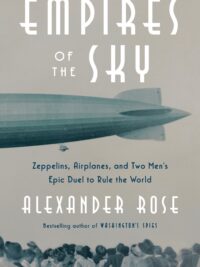At the dawn of the twentieth century, when human flight was still considered an impossibility, Germany’s Count von Zeppelin vied with the Wright Brothers to build the world’s first successful flying machine. As the Wrights labored to invent the airplane, Zeppelin fathered the wondrous airship, sparking a bitter rivalry between the two types of aircraft and their innovators that would last for decades in the quest to control one of humanity’s most inspiring achievements.
And it was the airship — not the airplane — that would lead the way. In the glittery 1920s, the count’s brilliant protégé, Hugo Eckener, achieved undreamt-of feats of daring and skill, including the extraordinary Round-the-World Voyage of the Graf Zeppelin.
At a time when America’s airplanes — rickety deathtraps held together by glue, screws, and luck — could barely make it from New York to Washington, Eckener’s airships serenely traversed oceans without a single crash, fatality, or injury. What Charles Lindbergh almost died doing — crossing the Atlantic in 1927 — Eckener effortlessly accomplished three years before the Spirit of St. Louis even took off.
Even as the Nazis sought to exploit Zeppelins for their own nefarious purposes, Eckener built his masterwork, the behemoth Hindenburg — a marvel of design and engineering. Determined to forge an airline empire under the new flagship, Eckener met his match in Juan Trippe, the ruthlessly ambitious king of Pan American Airways, who believed his fleet of next-generation planes would vanquish Eckener’s coming airship armada.
It was a fight only one man — and one technology — could win. Countering each other’s moves on the global chessboard, each seeking to wrest the advantage from his rival, the two men’s struggle for mastery of the air was not only the clash of technologies, but of business, diplomacy, politics, personalities, and their vastly different dreams of the future.
Empires of the Sky is the sweeping, untold tale of the duel that transfixed the world and helped create our modern age.



